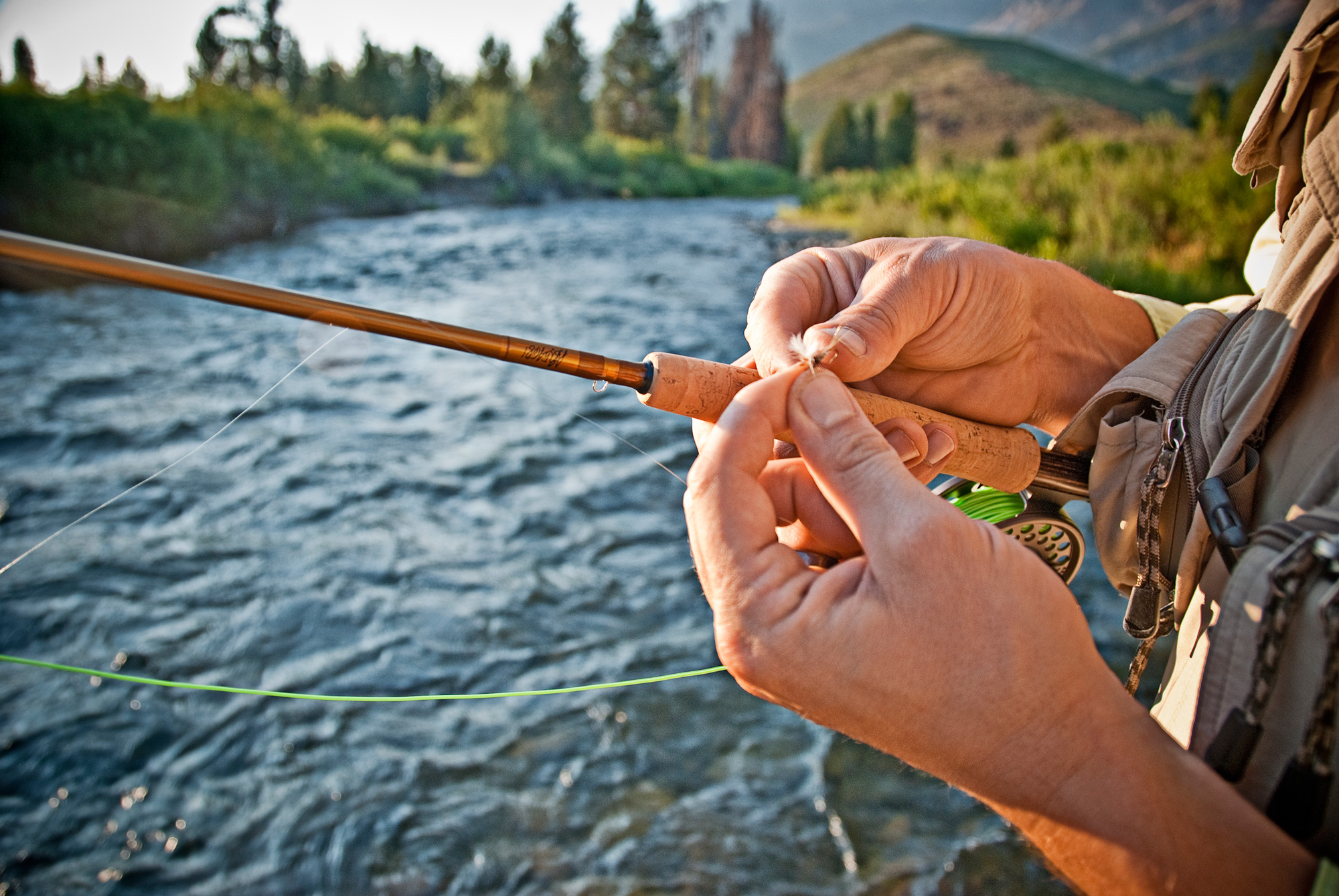
24 Jul Lesson 13: Diving Cadis
I SPENT A LONG WEEKEND ON THE WATER RECENTLY with Fred Trujillo, one of those professional tyers who is always fussing with patterns, trying to master fish by giving them the Right Fly. Unlike me, Fred’s a no-nonsense fisherman; if fish aren’t showing on the surface, he goes right down after them, never hesitating to load lead to his line. Not surprisingly, between his good flies and pragmatic methods, Fred catches a lot of fish — on this trip something like three or four to each one of mine.
Like I said, it was a long weekend — although, as a rule, I never do any serious score keeping, at least not when I’m on the short end. What was especially humbling, however, was that Fred was getting most of his fish on two patterns I first brought to his attention — or flies, at least, that I began using, years back, with enough success that Fred grew to favor them, too.
Naturally, as a pro, Fred has tweaked both patterns to his own liking. Yet there is nothing he has done to either the Diving Caddis or Wild Hare that seems significant enough to offer either fly a new name. Still, while he was outpacing me by a wide if imprecise margin, I was tempted to credit Fred’s success to some freshly brewed potion, a new twist of ingredients that was attracting trout to this pair of old favorites as if children to agates and flames.
But I know better. Red wire ribbing on the nymph’s abdomen? A tiny orange glass bead for the caddis’s head? Come on: Catching fish is rarely, if ever, exclusively about fishing the Right Fly. We would like to believe differently — but it just isn’t so. The last thing you change, goes the wisdom, is your fly — the very thought I recall having while I reached for my fly box as line again sizzled off Fred’s reel.
There’s an old story I suspect most fly fishers have heard since it first entered the literature in Tom McGuane’s The Longest Silence. McGuane reports having asked “the greatest trout fisherman” of his era what percentage of his annual catch would remain if he were reduced to fishing only Adamses and Gold-Ribbed Hare’s ears. “Certainly over 90 percent,” answered the famed angler. When asked, then, about the vast number of different patterns carried in his shop, the eminent piscator added, “I don’t sell flies to fish.”
Now and then I teach classes in beginning fly fishing, and when the subject of flies first comes up, I always share this story. When I finish, many of my students nod knowingly: they’ve been given some inside dope, weighty insight from a wily graybeard who really knows the sport. Better yet, their suspicions have been confirmed: All those different flies don’t matter — just another ruse of greedy marketers.
Later, however, I open fly boxes of my own. Invariably, someone asks, in a voice pitched toward wonder, if I tied all those flies. And there’s nearly always a fellow, a bureaucrat or middle manager, whose eyes reveal estimations of value based on rapid, cost-per-unit calculations. If only he knew the truth of a serious fly fisher’s stash. Finally, someone addresses the question directly: If flies don’t really matter, how come I have so many — and so many different kinds?
It’s a telling moment. I often feel a shift in power, a crumbling of authority I recognize from high school classrooms when a student finally asks why, if I’m so smart, I’ve settled for a job putting up with the likes of him. I have many answers — about flies, that is. Mostly I seek to point out the multitude of insects, and stages of their lives, on which trout feed. There’s also the Boy Scout argument: It’s good to be prepared. But sometimes I descend into the heart of the matter, the psychological tendency of most fly fishers to fear, above all else, the absence in their fly boxes of that fly that will win the day, a single pattern, amidst the infinite choices, that will make fools of feeding fish when the Adamses and Gold-Ribbed Hare’s Ears just won’t do, when the tried and true standards won’t touch that maddening 10 percent of the trout that even “the greatest trout fisherman” of an era will fail to catch if he doesn’t have the Right Fly.
The bureaucrat or middle manager is usually the first to wriggle. Or yawn. Or feign a polite, irritated cough. Once rolling, however, I find it difficult to stop. It’s not about the fly, I repeat. Okay, it’s rarely about the fly. You just want to have things covered. There are a lot of good flies out there, great flies, proven, traditional flies, classics and new takes on old ideas, old materials used in new ways, new materials used in old ways. It’s not about the fly — but you do try to have one that works.
The bureaucrat or middle manager glances towards the ceiling. Sophomores, I’m reminded, aren’t the only students I’ve ever pissed off. But I refuse to yield to perturbation.
“And like kisses,” I add, “if a fly is good, a dozen of them isn’t too many.”
Let me make this as clear as I can. On the one hand, you have those who believe that the solution to the problem of catching fish is the Right Fly. On the other hand, you have those who contend that the fly is but a very small part of the solution, and what matters most is the presentation of the fly. Superior presentation is the reason why the great trout fishermen of any era would suffer only slight reductions in their success if restricted to a pair of generic patterns, a dry fly and a nymph, each tied, presumably, in a half-dozen different sizes. Then again, driven to the wall on those occasions when they really did need a more specific pattern, these same anglers might well have hucked their rods into the river, taken up permanent stations at the nearest bar, and left the trout for the rest of us with our crooked casts and overflowing vests and fly boxes.
Naturally, most fly fishers stand somewhere between the two extremes. Yet every fly fisher I’ve ever met leans in one direction or the other. It’s tempting to generalize and say that newcomers to the sport gravitate toward the glamour of the Right Fly, while experience teaches most of us that our flies need be but approximate impressions, subjects to the demands of the accurate cast and efficacious drift. But we all know genuine hotshots who are shameless fly junkies, sober strategists and ruthless casters who would just as soon arrive at the river without a rod than without their library of flies.
Mostly, however, the cant of Real Guys favors the notion that what you do with your flies is more important than the flies themselves. In an article about fishing caddis hatches, Jim Schollmeyer makes no mention of the Diving Caddis, Gary LaFontaine’s redoubtable wet fly, a version of which my buddy Fred was using with such success during our long weekend together. Schollmeyer offers several presentation methods for how to imitate the swimming or spent egg-laying caddis females, that important stage in the caddisfly life cycle suggested both impressionistically and effectively by LaFontaine’s Antron-winged pattern. But not one of the 30 flies pictured in the article is specific to this stage of the caddisfly’s life. Instead, Schollmeyer gives us the generic soft hackle and a couple of standard, emerging adult patterns as sufficient imitations when coupled with the appropriate, subsurface presentation.
This is in no way an indictment of Schollmeyer. On the contrary, I use his article as evidence of another Real Guy who concerns himself more with the behavior of his flies than the infinitesimal details of patterns. Nevertheless, in the caddis-rich waters I fish, the Diving Caddis fools as many trout as any pattern I use, and I wasn’t surprised that weekend when Fred kept sticking fish with his version of Gary LaFontaine’s famous fly. Sure, he had altered the pattern. But that wasn’t why he was outfishing me, I kept telling myself, fiddling with splitshot, angles and lengths of casts, depths and speeds of drift, swings — all of the subtleties of presentation. The original Diving Caddis needs no improvements, I reminded myself. It’s always worked in the past. It’s not about the fly.
It’s not about the fly.
I wake at first light to the sound of rain on the roof of the van. Somehow this gives me an excuse to fall back asleep, an act of omission that is repaid with nightmares featuring small aircraft, a subway tunnel, my high school surfing buddy, and gangs of post-apocalyptic necrophiles straight out of the movie Mad Max.
I blame the previous night’s chili. Either that or a recent failure in romance that has left me all but sleepless two out of the past three nights. Or maybe I’m feeling the effects of watching Fred rope in a dozen trout to every handful of mine.
Fred’s tying at the picnic table, protected from the drizzle by an overhanging juniper, when I finally stumble out of the van. Materials are arranged neatly around his vise; the product of his early morning efforts is separated into two tidy piles. I know what this means: Wild Hares and Diving Caddis, Trujillo style.
Even without coffee, I venture closer inspection. It’s worse than I expected. Fred, who never talks much, less so in the morning, assumes the expression of a man who has received all the feedback he needs from a river full of trout. Or one who has been tying flies since dawn while his fishing partner oversleeps.
The flies, anyway, make my jaws hurt. I want to mention the elaborate sources of my troubled sleep. But this seems no time for theatrics. Fred’s flies reflect perfectly an attribute that Gary LaFontaine searched for throughout his own life, “effective fly patterns instead of just precise replicas.” Fred’s Diving Caddis, especially, produces in me a clenching of the teeth that mimics the exquisite tension I feel when nymphing with flies I absolutely believe in. This, I understand, is why our efforts at the vise do matter: As McGuane, among others, has reiterated repeatedly, the most successful anglers are those who are capable of fishing free of doubt and indecision, who rarely suffer the temptation to reach for their clippers and gaze at the contents of their fly boxes.
But it’s not about the fly, I remind myself, fumbling with my waders.
LaFONTAINNE DIVING CADDIS
Hook: Mustad 7957-B (a standard wet fly hook)
Body: Sparkle Yarn: blend of clear and dyed filaments chopped into dubbing
Underwing: Soft-hackle fibers: grouse, partridge, or hen hackle
Overwing: Clear Antron (or Creslan filaments)
Hackle: Rooster hackle
Tying Notes: What’s startling about this pattern is both its simple design and how quick and easy it is to tie. The fly itself appears almost crude, certainly one of the reasons it’s never been particularly popular either commercially or for those who feel they need to tie sophisticated or “realistic” flies. Photos of the Diving Caddis tied by Gary LaFontaine himself inevitably prompt one to think, Couldn’t he have been a little neater? Most tyers now use packaged Antron dubbing or a blend of Antron and rabbit fur for the body, eliminating some of the pattern’s shaggy appearance, conceivably at a cost to the fly’s overall effectiveness. The layered, two-part wing is as easy as wings come. A single turn of hackle — never more — creates a sparse collar, conveniently forced back toward the body with wraps of thread.
FRED’S DIVING CADDIS
Hook: Hook: Mustad 3906B, size 14-16
Thread: 8/0 Rusty Brown UNI-Thread
Beadhead: Dark brown glass bead, 11/0-15/0
Body: Superfine Dubbing, tan
Underwing: Antron, cream
Overwing: Deer hair
Thorax/Head: Squirrel dubbing, natural tan/gray
Tying Notes: About glass beads I can only say that Fred and lots of other tyers like them, and they’re always on the lookout for new sources, colors, and sizes. You usually need to pinch down the barb of the hook to slip the bead on. Fred uses Superfine dubbing, aiming for a realistic-size body. The big change-up on his pattern, however, is the use of Antron as an underwing; how this affects the pattern is anyone’s guess, but clearly you still get the bubble-collecting properties of Antron filaments, the “magic ingredient” in all of LaFontaine’s original caddis patterns. The deer hair overwing should be sparse compared to typical adult floating patterns. For the dubbing material used up front, Fred shaves the fur from squirrel skins with dog clippers. A commercial tyer, he hates fussing with dubbing loops, but he always seems to end up with just a few of those spiky barred guard hairs that look like both legs and antennae at the head of the fly, the same look created by rooster hackle in the original Diving Caddis.
- Flies tied by Denny Waln at The Grizzly Hackle in Missoula, Mont.
- Flies tied by Denny Waln at The Grizzly Hackle in Missoula, Mont.




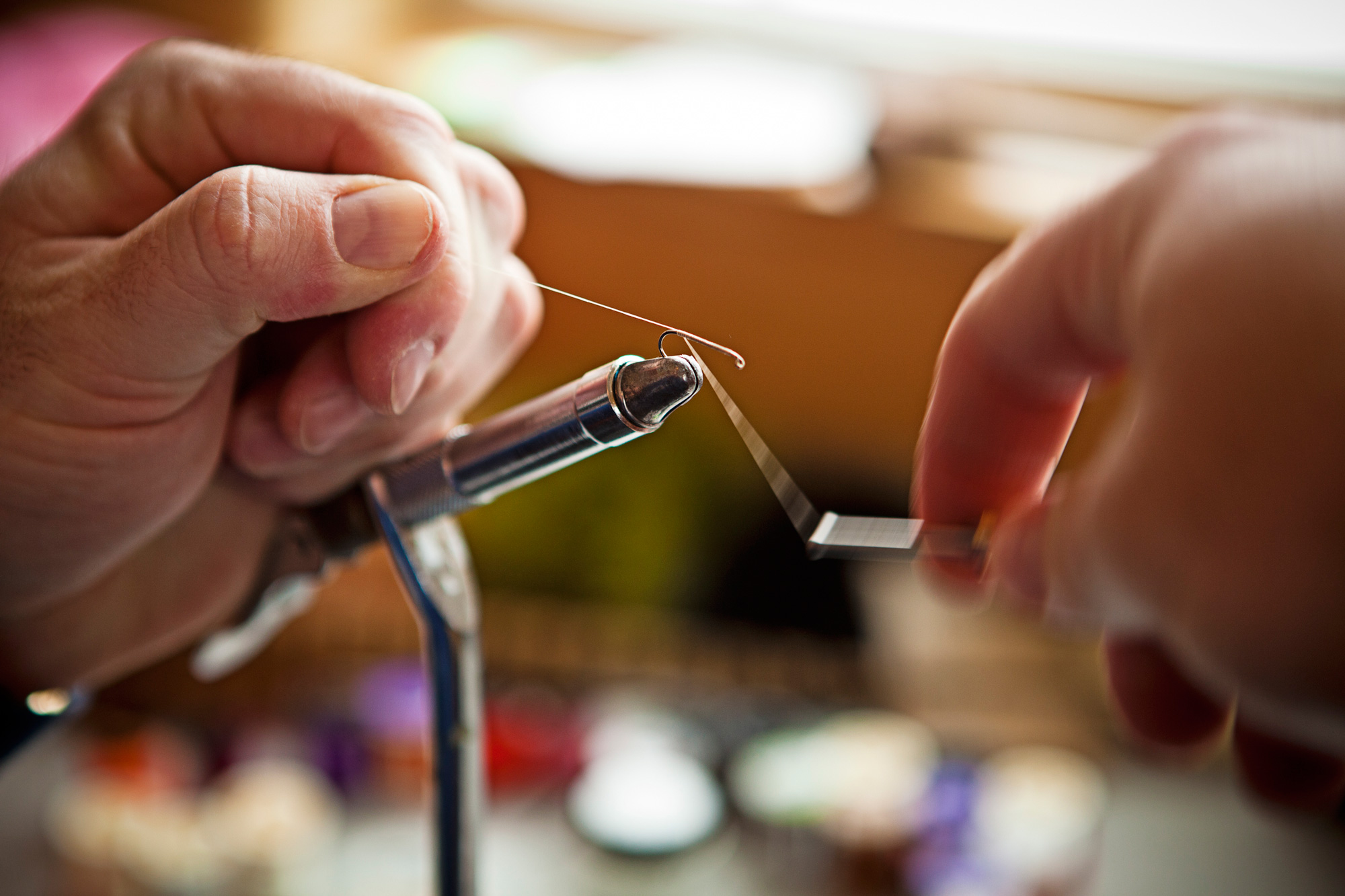
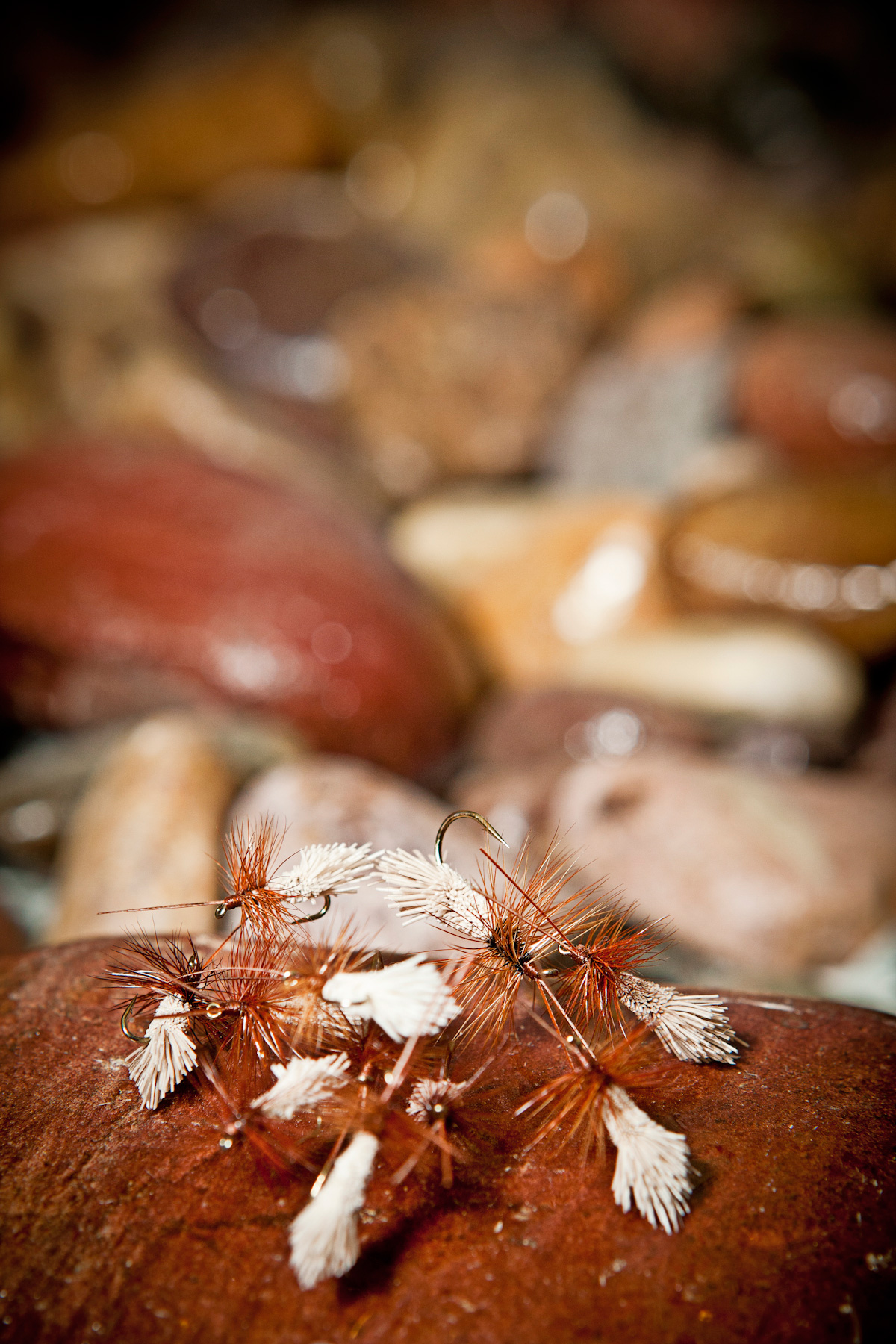
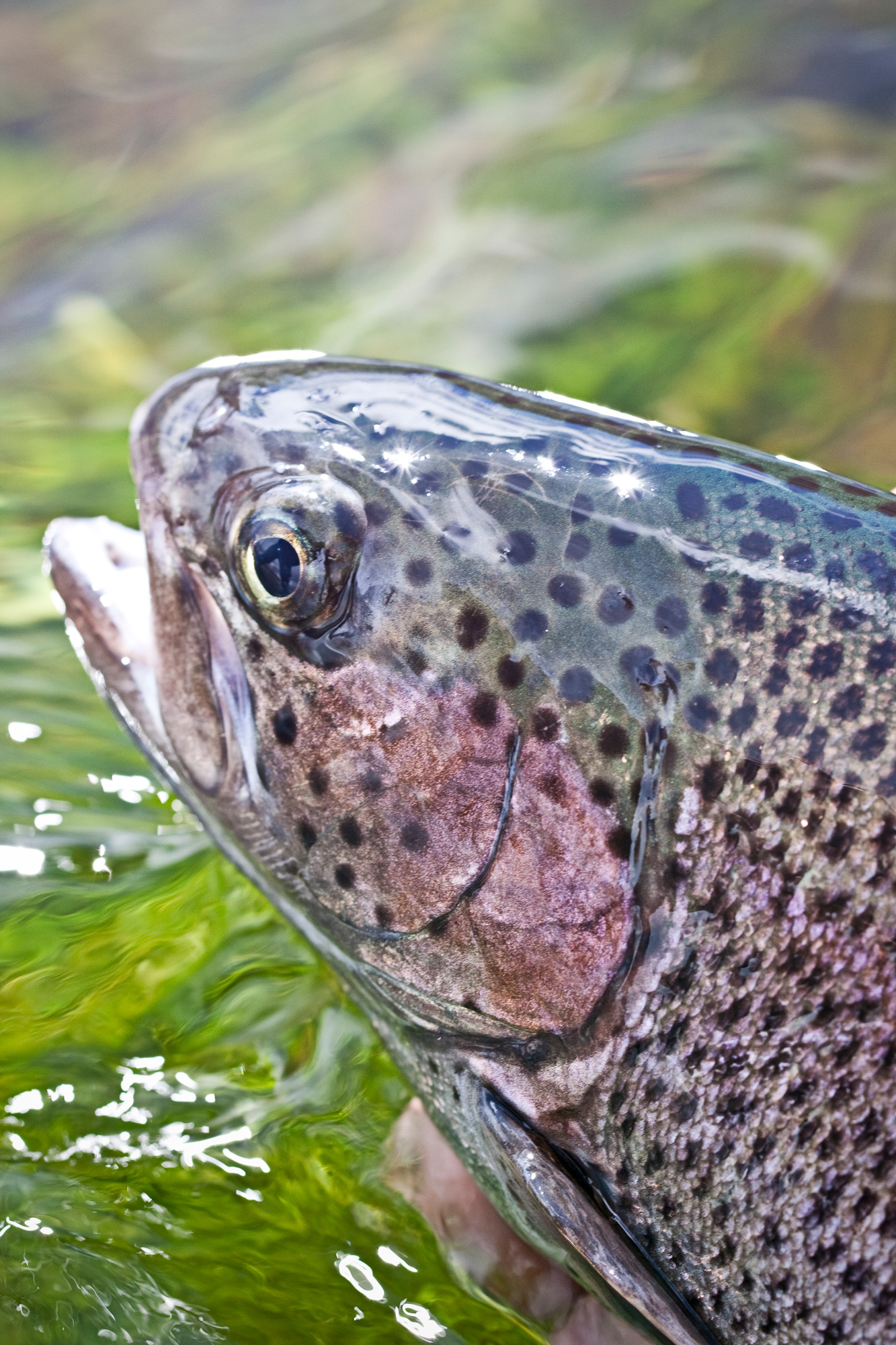

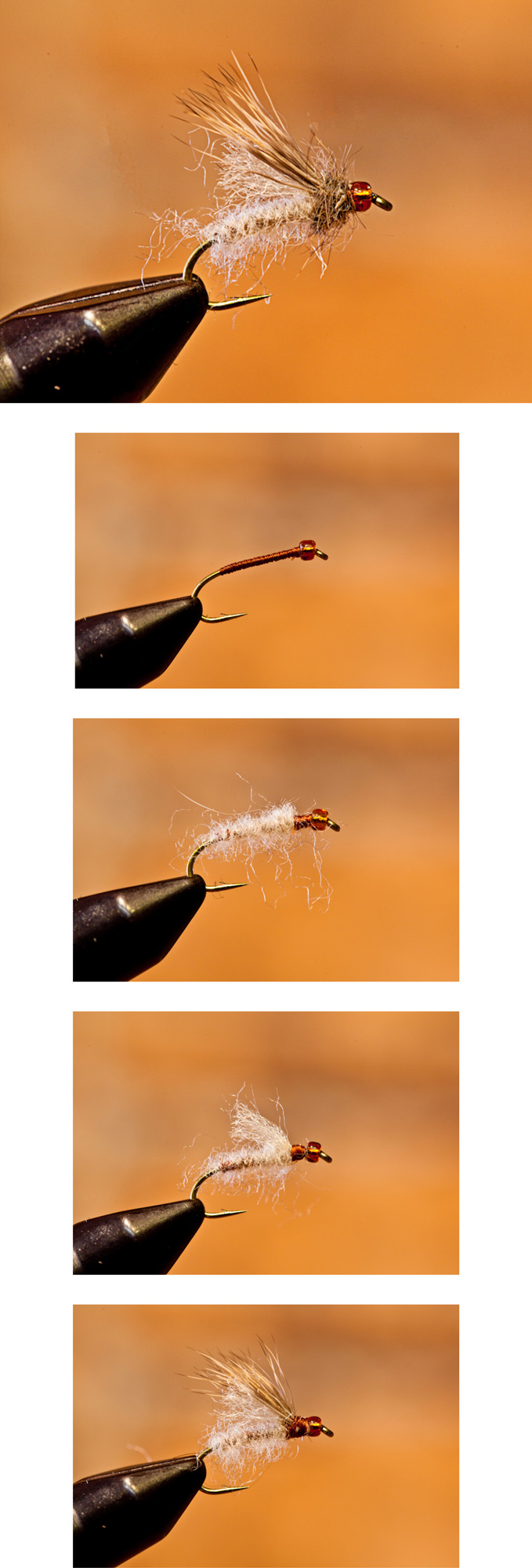

Russ
Posted at 23:44h, 04 AprilDo you swing or dead drift these Flys?
Russell ogden
Posted at 22:18h, 20 OctoberHow do you fish a diving caddis?